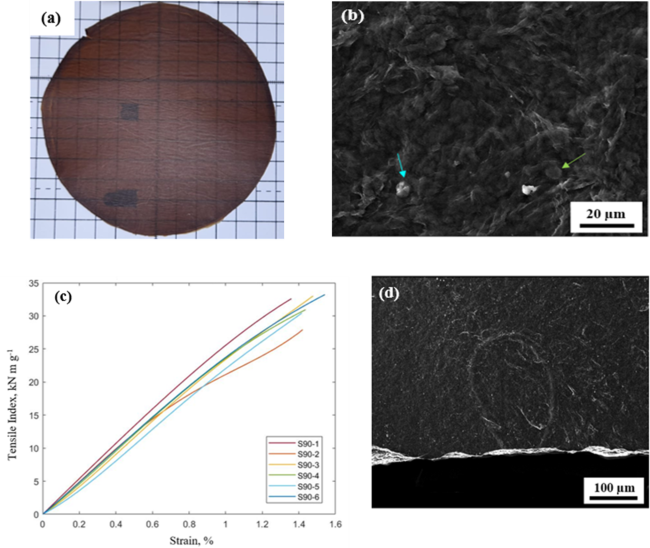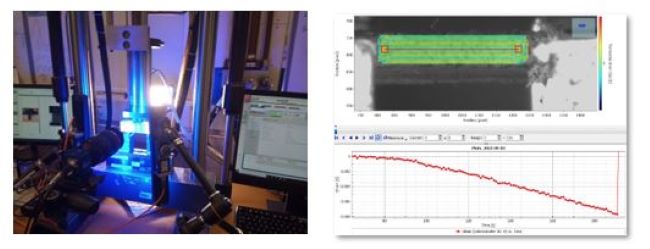Extended projects 2021 cohort
Research projects
- Structure-property relationships of mushroom-derived chitin nanopapers
- Determining allowable mass for sectional wind turbine blade joint
- Damage mechanism analysis of QI carbon/glass hybrid laminates subjected to quasi-static indentation using axisymmetric model
- Imaging of progressive damage in Open Hole Compression (OHC) tests of hybrid carbon/glass fibre-reinforced composites
- Crack resistant polymer matrices for cryogenic liquid hydrogen storage
- Novel, bioinspired, aligned-discontinuous reclaimed fibre composites for enhanced compressive performance
- Challenges in large-scale modelling of textile damage: implicit vs explicit
- Development of a 1D crystallisation through-thickness model for thermoplastic composites in MATLAB
- Composite structural housing with integrated thermal management
- Modal nudging and elastic tailoring for blade-stiffened wing structures
Structure-property relationships of mushroom-derived chitin nanopapers
 Student: Stefania Akromah
Student: Stefania Akromah
Supervisors: Steve Eichhorn, Neha Chandarana, Liangbing Hu (University of Maryland)
While cellulose is a well-known natural polysaccharide predominantly found in the cell walls of plants, chitin constitutes the backbone of the cell walls of fungi and is finding renewed interest in the field of advanced materials. In this work, the tensile properties of A. bisporus mushroom-derived chitin nanopapers are characterised and related to their physical and structural properties.
The deformation and failure mechanisms are also described and compared to those of cellulose nanopapers. The chitin nanopapers displayed a linear-elastic behaviour up to fracture with no evidence of plastic deformation, as confirmed by the smooth edge of the fractured edge (Fig. 1).
The UTS, stress to failure, strain at failure, and elastic modulus were found to be 26.2-31.4 kN m g-1, 26.2-31.4 kN m g-1, 1.0-1.4%, 23.8-29.2 kN m g-1, respectively. The low tensile properties are associated with the size distribution of the chitin nanofibrils, ranging between 18-32 nm (~25 nm mean), the random orientation, and the presence of amorphous glucans: these reduce the interfibrillar hydrogen bond density. Thus, to improve the strength of these materials for use in advanced applications the structure, size, and orientation of the nanofibrils must be optimised.

Figure 1 (a) A typical mushroom-derived chitin nanopaper and (b) SEM micrograph showing the densely packed microstructure, Ca-crystals (blue arrows). (c) Representative stress-strain curves of the tested chitin nanopapers specimens. (d) Typical SEM micrographs of fractured edge of failed specimens.
Determining allowable mass for sectional wind turbine blade joint
 Student: Tom Brereton
Student: Tom Brereton
Supervisors: Paul Weaver, Alberto Pirrera, Terence Macquart
The further development of renewable technologies is essential in the aim for a zero-carbon society. One such development is the elongation of wind turbine blades leading to increased power output. However for end-of-life and transportation purposes, it is advantageous to design these longer blades as ``sectional''. A key research area for sectional wind turbine blades is understanding the dynamic effect that modularisation could have on blade performance. This project uses the Aeroelastic Turbine Optimisation Methods (ATOM) software to numerically evaluate the allowable mass of the joint, at varying division locations. In this work, ``allowable'' is defined as the maximal concentrated mass that can be added to the blade before detrimental dynamic effects are introduced. This is determined by considering a modal analysis of the blade as well as investigating the change in strength and buckling failure indices as a result of the additional mass.
Damage mechanism analysis of QI carbon/glass hybrid laminates subjected to quasi-static indentation using axisymmetric model
 Student: An Chen
Student: An Chen
Supervisors: Michael Wisnom, Luiz Kawashita, Stephen Hallett, Xun Wu
Carbon fibre reinforced polymer (CFRP) materials have excellent specific in-plane properties and are widely used in primary structures of aircraft. However, CFRP is vulnerable to out-of-plane loading due to lack of through-thickness reinforcement and low strain to failure. Impact is a typical loading in the through-thickness direction and is important in many aerospace applications for safety and certification, e.g., engine casings and wing leading edges. A series of experimental work in Bristol has shown that, hybrid laminates composed of carbon and glass fibre have superior impact performance to that of CFRP, however, the underlying mechanisms for the improvements are not well understood.
In this work, an efficient two-dimensional axisymmetric finite element model was established to simulate the response of the laminates against quasi-static indentation for the aim of understanding the factors controlling the response as well as the detailed damage mechanisms of the laminates under low-velocity impact. Half of the through-thickness cross section of the laminates that parallel to the fibre direction was constructed in ABAQUS/Explicit. The model was based on two-dimensional solid elements compatible with interface finite elements, which allows to model intralaminar fibre failure and interlaminar delamination, respectively. The benefit of employing axisymmetric model is that the through-thickness stresses obtained from it is particularly effective to be used for the analysis of local events like penetration, thus reducing the high computational cost presented in the state-of-the-art three-dimensional impact modelling.
The preliminary numerical results on the baseline carbon fibre composites have shown good agreement with experimental results, thus validating the proposed model. The analysis presented the interaction between fibre failure and delamination as well as how this controls the impact behaviour of laminate. This work represents one of the first step towards the understanding of the detail damage mechanisms of hybrid laminates.
Imaging of progressive damage in Open Hole Compression (OHC) tests of hybrid carbon/glass fibre-reinforced composites
 Student: Eleni Georgiou
Student: Eleni Georgiou
Supervisors: Richard Trask, Gustavo Quino Quispe, Ian Hamerton
Hybrid composite laminate architectures, which contain low and high elongation fibres within a common matrix, can be designed to alter failure mechanisms to introduce more progressive damage and increased failure strains in compression. They also have the potential to reduce the notch sensitivity of composites. Here, an experimental study was presented that explored the effect of the hybridisation of 0° layers on the failure response of notched composites in compression. Open-hole compression (OHC) tests were conducted in accordance with ASTM D6484. Three carbon/glass hybrid configurations were compared to a baseline carbon laminate, all with an identical cross-ply stacking sequence ([902/05/902/0]s). The effect of varying the position of the 0° glass layers on the compressive strength, failure strain and failure mechanism was explored. Post machining, C-scanning was performed to assess any defects or voids present in the samples before testing. Failure mechanisms were investigated via Digital Image Correlation (DIC) and edgewise optical microscopy to detect damage on the surface and inner plies, respectively. Post-mortem X-ray CT imaging was also undertaken to compare the type of damage between configurations. The hybrid configuration containing two central 0° glass fibre layers showed equivalent OHC strength with 13.5% greater global failure strain compared to the baseline samples. Overall, the effect of hybridisation of 0° plies on the OHC strength and failure mechanisms was found to be heavily dependent on the position of the glass within the laminates and further investigation is required to determine more optimal configurations in compression.

Figure 1: A carbon/epoxy composite sample being tested under uniaxial compression at cross head speed of 1 mm/min. The test was conducted under the guidelines outlined in ASTM D6484 for OHC testing, and the strains were measured using a DIC setup.
Crack resistant polymer matrices for cryogenic liquid hydrogen storage
 Student: James Griffith
Student: James Griffith
Supervisors: Ian Hamerton, Valeska Ting, Karthik Ram Ramakrishnan, Sebastien Rochat, Marcus Walls-Bruck
With the international drive to Net Zero by 2050, the aviation industry is under increasing pressure to pivot to zero-carbon emission fuel sources in the coming decades. Liquid hydrogen (LH2), a cryogenic liquid stored at 20 K (-253°C), has been identified by the UK’s Aerospace Technology Institute as the primary sustainable fuel source to serve the majority of the aircraft market in the future. This has led to a rapidly increasing demand for lightweight storage tanks to contain LH2. While metallic tanks might be first to market, carbon fibre reinforced polymer (CFRP) tanks offer significant weight saving potential, which translates to considerable cost savings over the lifetime of a storage tank. How composite materials perform at cryogenic temperatures is therefore a crucial factor in enabling the use of composite LH2 tanks aboard the aircraft of the future. While CFRP tanks are considered promising long-term storage vessels, the build-up of thermally induced residual stresses and subsequent susceptibility of the polymer matrix to microcracking at these extremely low temperatures is currently a primary barrier to adoption.
One cause of polymer matrix microcracking is thermal shock. When rapidly cooled down to cryogenic temperatures a composite material can experience thermal shock via inhomogeneous temperature distributions, where neighbouring domains encounter different temperatures, creating a steep temperature gradient across the material. This can result in the development of transient thermally induced stresses and subsequently cause microcracking. In this study, the impact of thermal shock via cryogenic cycling on four commercially available epoxy nanocomposite resins was investigated. The aim was to determine its significance as one of the main mechanisms for microcrack formation and to correlate the extent of microcracking to the presence of different resin toughening agents and the change in thermophysical properties of the material during thermal cycling.
Novel, bioinspired, aligned-discontinuous reclaimed fibre composites for enhanced compressive performance
 Student: Ian Lee
Student: Ian Lee
Supervisors: Giuliano Allegri, Laura Pickard, Ian Hamerton, Marco Longana
The aim of this summer research project was to comparatively characterise the compressive properties of a carbon-fibre/epoxy composite, manufactured from highly aligned discontinuous fibres. Fibre tapes were produced using the HiPerDif method developed at the University of Bristol. This processing system is a promising source of material for a range of hybrid, hierarchically architectured structures currently being investigated within the NextCOMP research programme, aimed at developing the next generation of composite materials with significantly improved compressive load carrying characteristics.
Composite materials have long been recognised as exhibiting compressive strength characteristics some 40% below their in plane tensile properties. In addition, the prior literature has predominantly focused on continuous fibre composites with little research into the properties of aligned discontinuous fibres. This project comparatively investigated a composite featuring discontinuous reinforcement alongside a standard prepreg of continuous fibres. The samples were tested using a novel bending experiment developed to characterise compressive behaviour whilst minimising strain gradient and ensuring consistent sample failure.
Figure 1 - Compression testing using novel 4-point bend test and Digital Image Correlation of results
The project found that the samples tested, whilst displaying a certain level of fibre alignment and consistent material properties, failed due to delamination, and buckling rather than in true compression. Failure analysis of the samples allowed a partial characterisation of the material, identified the erroneous failure mechanism as a consequence of the processing methods chosen and outlined potential remedial actions to be undertaken during the wider PhD project.

Figure 2 - SEM imaging of test samples illustrating; a) linear delamination, b) sample deformation resulting from buckling
Challenges in large-scale modelling of textile damage: implicit vs explicit
 Student: Christian Stewart
Student: Christian Stewart
Supervisors: Stephen Hallett and Bassam Elsaied
There is a growing use of textile composites across several industries due to their increased damage tolerance. This growth, however, is dependent on the ability to model their behaviour efficiently. This is especially true when modelling textiles at structural scales, due to the associated high computational cost. Implicit finite element (FE) methods can encounter convergence difficulties when solving highly non-linear material behaviour, such as progressive damage in textile composites. Therefore, explicit FE methods may provide a more robust alternative. In this study, an implicit and an equivalent explicit subroutine are compared through simulating a single layer of 5-harness satin (HS) weave under quasi-static, tensile loading. The two solvers are primarily compared on the ability to capture damage on the macroscale, however, the damage onset and evolution at the meso-scale is also addressed to understand the underlying physics. The two solvers are also compared in terms of model scalability, since the key interest is modelling damage at the structural scale, where large-scale models are necessary.
Development of a 1D crystallisation through-thickness model for thermoplastic composites in MATLAB
 Student: Maria Veyrat Cruz-Guzman
Student: Maria Veyrat Cruz-Guzman
Supervisors: Dmitry Ivanov, Jonathan Belnoue, Steve Eichhorn
Thermoplastic interfaces have been shown to affect bulk mechanical properties and can have a critical role in the composite’s performance. Most thermoplastic interface healing models are based on theories developed initially for amorphous polymers such as de Gennes Reptation theory, hence do not tend to account for the effect of crystallisation in semicrystalline polymers. The inclusion of crystallisation into healing models will result in more accurate predictions for interface strength. The project will aim to develop a 1D model in MATLAB ver. 2021.a for the crystallisation through-thickness of a thermoplastic polypropylene composite during the heating cycle. Optimisation trials will then be run for different cooling cycles to determine if the crystallinity at the interface and bulk can be optimised. Results from the model show the success of a proof-of-concept model and that it is possible to optimize the crystallinity of the composite by modifying the cooling cycle. The aim is to later create an interface healing model and see the effects of crystallisation on the thermoplastic interface.
Composite structural housing with integrated thermal management
 Student: Toby Wilcox
Student: Toby Wilcox
Supervisors: Ian Bond, Richard Trask, Ian Farrow
As modern rotorcraft design shifts away from conventional power and towards more electrical systems, the need for efficient thermal regulation has never been higher. Systems are currently in place to combat this in rotorcraft but they would benefit from higher integration and optimisation. The key to achieving this may lie in further utilisation of materials that are already commonplace in the aerospace industry; composites. Composite materials, namely carbon and glass fibre reinforced composites (CFRPs/GFRPs) have widespread applications in modern aircraft and can comprise as much as 40-50% of structural components. The prevalence of composite materials is mainly due to their high strength-weight ratio and stiffness tailoring ability. They are however limited in temperature critical areas due to their poor thermal performance. This means they are generally unsuitable for structural applications around components that require a large amount of heat removal. However, if the thermal performance of these composite materials could be improved without compromising the mechanical properties of the material itself, the benefits would be numerous.
This project aims to investigate ways to improve the thermal characteristics of composite materials in ways that would aid the removal of heat from temperature critical components. There are currently a few novel concepts that can do this on a small scale, but current literature and research into the area is scarce. This likely means a new technique, or a combination of techniques would have to be used to achieve this. There are two types of techniques that could be used; passive and active cooling. A passively cooled system would employ microstructural or geometric features and take advantage of the surrounding environment to promote heat dissipation without the need for energy consumption. Microstructurally, this may include thermally conductive additives into the composite matrix or improved crystallinity within the matrix. Geometrically, this may involve ventilation features that take advantage of the surrounding conditions and the airspeed produced by the rotors. Possibly the most promising concept however would be to improve thermal conductivity in the through-thickness direction of the composite using z-pinning for tufting (stitching). This would create thermally conductive pathways within the structure with more conductive materials such as carbon or metals. These two techniques already have uses from a mechanical performance perspective, but their thermal effects have not been investigated in research. Preliminary experiments have already been carried out to investigate z-pinning as part of this project, with promising initial results.
An actively cooled system would require some means of energy consumption in order to remove heat from the system. This would most easily be done by pumping a cooling fluid around the surface of the structure. Some similar systems exist in the modern rotorcraft but integration into composite structures is very complex. Channels can however be embedded within the composite to create a ‘vascular network’ through which coolant can be pumped. Based on the limited literature, this technique offers the most potential to achieve the cooling effect required, and will form the bulk of the experimental work of this project. The size, configuration, and fabrication method of the channels are all factors that need to be investigated further, as well as choice of coolant and flow velocity. These variables will create a strong starting point for research.
The project will use a two pronged approach to evaluate both passive and active systems experimentally, before identifying the concept with the highest potential. This concept will then be evaluated in more detail and with a specific application in mind, in the hopes of raising the TRL level and furthering the research for future projects.
Modal nudging and elastic tailoring for blade-stiffened wing structures
 Student: Lichang Zhu
Student: Lichang Zhu
Supervisors: Alberto Pirrera, Rainer Groh, Mark Schenk, Jiajia Shen
Modal nudging is a recently introduced tailoring technique for thin-walled structures, whereby mode shapes from the post buckling regime are seeded as initial perturbations to the geometry of the perfect structure. The small alterations to the geometry of a thin-walled structure can be used to connect stable pre-buckling responses to stable post-bucking ones. This characteristic increases the load carrying capability of the structure by removing critical bifurcations and stabilising the post-buckling response removing any of the undesirable instabilities which may typically be encountered post-bucking. However, this is not possible in certain applications like the upper skin of a wing since the shape of the upper surface cannot be changed due to aerodynamic reasons. An updated version of modal nudging is proposed called Thickness Nudging. Thickness nudging uses the shifting of neutral axis to achieve modal nudging by changing only one of the surfaces of a thin-walled structure. This three-month project demonstrates thickness nudging on a 2D slender structure (Roorda frame). This project increases the applicability of modal nudging and makes it a possible solution for weight saving in wing structures.

